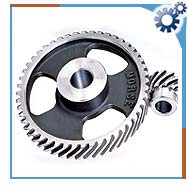 Helical gears connect parallel shifts but the involute teeth are cut at
an angle to the axis of rotation. Two mating helical gears must have
equal helix angle but opposite hand. They run smoother and more quietly.
They have higher load capacity, are more expensive to manufacture and
create axial thrust.
Helical gears connect parallel shifts but the involute teeth are cut at
an angle to the axis of rotation. Two mating helical gears must have
equal helix angle but opposite hand. They run smoother and more quietly.
They have higher load capacity, are more expensive to manufacture and
create axial thrust. Helical gears can be used to mesh two shafts that are not parallel and can also be used in a crossed gear mesh connecting two perpendicular shafts. They have longer and strong teeth. They can carry heavy load because of the greater surface contact with the teeth. The efficiency is also reduced because of longer surface contact. The gearing is quieter with less vibration.
Gear Configuration
They can be manufactured in both right-handed and left-handed configurations with a helix angle to transmit motion and power between non-intersecting shafts that are parallel or at 90 degrees to each other. For shaft at 90 degrees, the same helix angles are used and the tooth contact area of the gear is very small. If the angle of gear teeth is correct, they can be mounted on perpendicular shaft by adjusting the rotating angle by 90 degrees. The inclination of the teeth generates an axial force. As the angle of inclination increases the axial force also increases. Thrust bearings can counter these forces.
Applications
These are highly used in transmission because they are quieter even at higher speed and are durable. The other possible applications of helical gears are in textile industry, blowers, feeders, rubber and plastic industry, sand mullers, screen, sugar industry, rolling mills, food industry, elevators, conveyors, cutters, clay working machinery, compressors, cane knives and in oil industry.
Disadvantage
A disadvantage of helical gear is the resultant thrust along the axis of the gear, which needs to be accomodated by appropriate thrust bearings. This can be overcome by the use of double helical gears by having teeth with a 'v' shape.